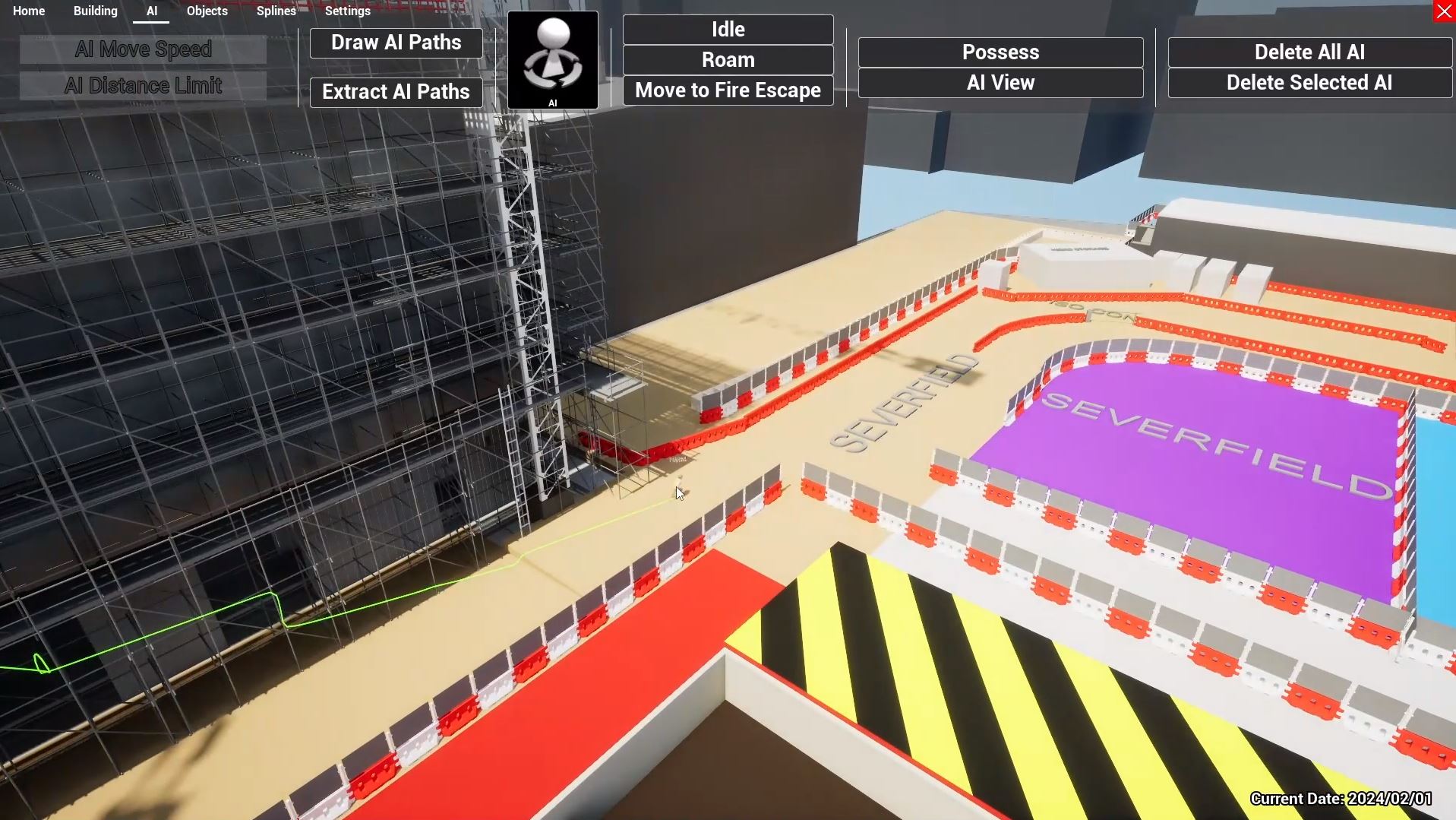
Construction site escape routes and emergency exits should be regularly reviewed – and using AI-based software to do this saves times and could save lives, says Proicere’s Karl Dooner.
AI is transforming health and safety planning in construction, offering up-to-date, adaptive solutions for minimising the risks on busy, dynamic sites. By integrating 4D modelling with AI technology, construction teams can visualise, predict and mitigate safety hazards more effectively than ever before.
Health and safety plans on construction sites require frequent adjustment due to the ever-evolving nature of these environments. Changes in workforce and weather conditions, construction phases, and the introduction of new equipment, temporary works and contractors all present unique hazards.
One of the biggest, but arguably underappreciated, health and safety risks on major and complex construction projects is the frequently changing escape routes for workers on site, with the introduction of dead ends.

“Traditional health and safety planning methods that rely on drawings, paper and pen, are insufficient for maintaining oversight on a fast-evolving construction site.”
Health and safety plans can become quickly outdated. Without an easily updatable system to manage those plans and communicate changes as they occur, the risk of accidents increases, potentially putting our workforces at risk.
In a recent example, an employee of an engineering firm at a construction site was seriously injured after falling from a height, as stair treads had been removed to allow a conveyor’s stairway to be supported by a crane.
One of the advantages of using advanced digital modelling and planning tools is that site teams can access up-to-date data concerning risks on a site and coordinate the placement of teams accordingly. Therefore, sadly, this accident could have been avoided. While we all strive to send our teams home safely every day, avoiding such accidents requires constant vigilance and planning.
Desk-based planning vulnerabilities
Traditional health and safety planning methods that rely on drawings, paper and pen, are insufficient for maintaining oversight on a fast-evolving construction site. An escape route drawn out on a static site map rarely remains the quickest and safest way to exit in an emergency through the lifetime of a site. A safe route one day may become a higher risk route the next, once a different team is on site or works move into a different area. Additionally, paper-and-pen methods carry a high risk of error due to significant manual input, are time-consuming for developers, and are difficult for contractors to understand comprehensively.
To overcome these challenges, a solution has been developed by Proicere that combines the 4D modelling of the construction programme and site, with AI technology and gaming capabilities. This approach allows for the simulation and visualisation of site workings and potential complications that could impede safe escape routes.
AI-based site safety solution
There are several key features to AI that enable superior levels of safety compared with 2D desk-based alternatives.
“During one digital run-through of escape routes, a client discovered that a key route was blocked by scaffolding that was due to be installed. This enabled them to change the configuration of the scaffolding before installation, removing the risk.”
First is its capability for visualisations. By integrating time-related information with 3D modelling, 4D tools allow construction professionals to visualise the sequence of construction activities over time. By providing a step-by-step visual representation of the construction sequence, 4D tools help identify potential issues or clashes before they occur on site, reducing the risk of costly delays and rework.
Second, it offers dynamic route optimisation. Based on the simulation, the AI navigates through the complexities of the site, choosing optimal routes and recording distances travelled to maintain safety standards.
Third is its capability for updated, daily synchronised risk assessments. As the site changes, the site teams can reproduce the changes to the site, quickly and visually.
This allows the project team to quickly check each day’s risks and changes to escape routes. Accurate, personalised maps can also be provided to each team, specific to their work location and potential risks they may face.
Benefits of AI-based software
AI-based software brings benefits in areas such as risk mitigation, emergency planning, personnel engagement, communication and efficiency.
Proactive risk mitigation The system identifies site flaws and risks that would otherwise remain undetected, allowing for pre-emptive changes to site configuration. Using predictive analytics, AI can analyse large amounts of site data to identify trends and predict potential safety hazards, enabling contractors to implement preventive measures and reduce the likelihood of accidents. These models use data, such as safety compliance records, inspections, observations and daily worker hours, to anticipate risks before they escalate.
For example, during one digital run-through of escape routes, a client discovered that a key route was blocked by the presence of scaffolding that was due to be installed. This enabled them to change the configuration of the scaffolding before installation, therefore removing the risk.
Improved emergency planning Interventions based on AI modelling address potential risks in existing corridor plans, optimising fire escape routes.
Enhanced worker engagement The visual and interactive nature of the system improves coordination among multiple contractors and increases overall engagement with safety protocol.
Improved communication 4D visualisation methods give users a visually intuitive and realistic representation of the site over time, making it a more effective communications tool for all stakeholders – and, essentially, the workforce.
Time efficiency The speed and ease of risk assessment free up resources for health and safety teams, meaning those teams can concentrate on other valuable tasks, such as safety inductions and coordination meetings.
The integration of AI into health and safety planning for construction sites represents a significant advance in protecting worker wellbeing. By providing up-to-date, data-driven insights and dynamic risk assessments, AI is enabling construction teams to create safer, more efficient work environments. As this technology continues to evolve, it promises to set new standards for safety management in the construction industry.
Karl Dooner is chief executive of Proicere.
Don’t miss out on BIM and digital construction news: sign up to receive the BIMplus newsletter.











